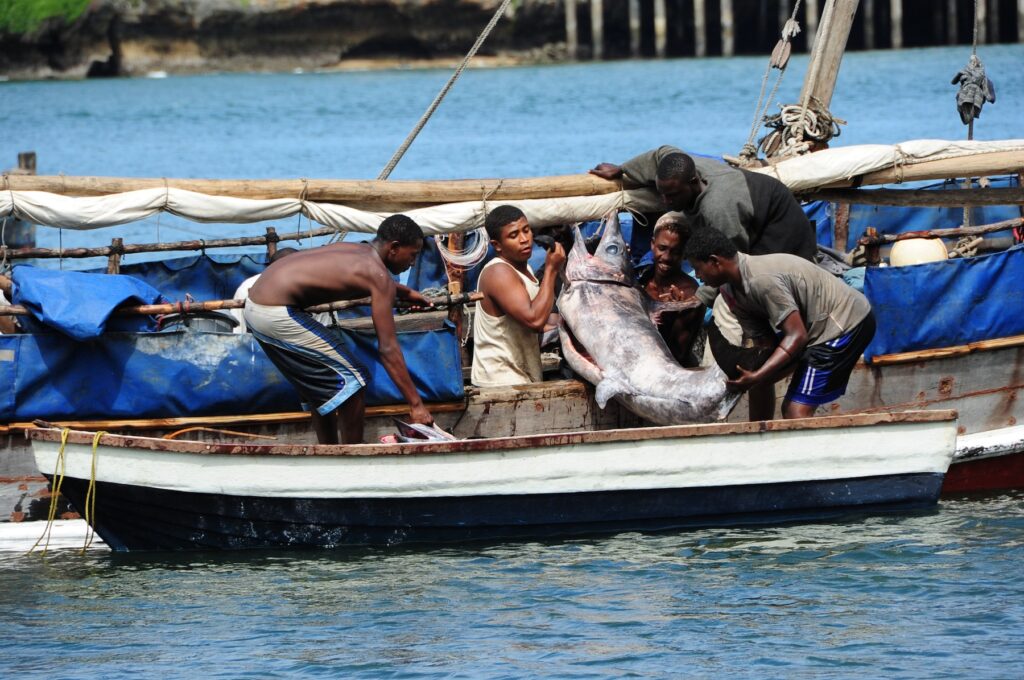- In May, Tanzania took a bold but risky step by banning fishing on Lake Tanganyika for three months.
- In the Lake Victoria fishing zone, a new challenge, the smuggling of fish maws, is denying the government revenues.
- Statistics show that Tanzania is also experiencing reduced volumes of Nile Perch caught in Lake Victoria.
Tanzania’s water bodies alone hold plenty of economic activity potential, including the opportunity to harness the country’s billion-dollar fishing industry.
Records from the Ministry of Livestock and Fisheries show that the industry employs nearly 200,000 people directly. Another 4.5 million individuals benefit from the fishing industry’s value chain in Tanzania.
Tanzania’s fishing industry share of GDP
Tanzania’s fisheries contributed 1.8 per cent to the GDP last year and expanded by at least 2.5 per cent. The sector, despite displaying plenty of potential for creating jobs and powering the economy is facing a myriad of challenges. From Tanzania’s vast lakes to the Indian Ocean, players in Tanzania’s fishing industry are grappling with a myriad of woes.
In May, the government took a bold but risky step declaring a fishing ban on Lake Tanganyika for three months. The measure, which left local communities ruffled, was to give room for fish to reproduce following what authorities say is due to overfishing.
“I have been fishing for more than ten years. These waters provide for my basic needs and family. This ban would incapacitate my livelihood so much,” said Juma Salumu, a fisherman in Kigoma, off Lake Tanganyika.
Small-scale fishers and aquafarmers
Overall, Tanzania’s fishing industry is dominated by small-scale fishers and aquafarmers. Combined, they are contributing over 95 per cent of the East African country’s total catch.
On the other end, Lake Victoria – a vast resource shared with Uganda and Kenya – a new challenge, fish maws, is rearing its ugly head. Surging demand for fish maws is shifting the attention of fishermen.
Fish maw is one of the most expensive parts of a fish derived from a swim bladder or air bladder. The swim bladder of big sea fish is sun-dried to become a fish maw product. Fish maw is a kind of precious traditional Chinese ingredient. It is also one of the four valuable seafood members namely: abalone, sea cucumber, shark’s fin and fish maw.
As Tanzani’s fishing industry struggles with overfishing, market shifts are crushing the proper trajectory of the sector.
The Citizen, reports that fish maws, which are used largely for texture and flavour absorption in soup, are impacting fishing in Lake Victoria.
“This, together with a drop in European fish demand and some illegal fishing in Lake Victoria, among other issues, has been driving down fish exports in recent months,” The Citizen said.
Tanzania fishing industry is noted for its massive volumes of fish exports. However, the exportation of the products has suffered significant cyclical trends over the past decade.
On one hand, fish exports rose by 82 per cent in the past four years due to the rising volume of catch. A number of tax reforms in the sub-sector helped drive up the export volumes.
Statistics from the Ministry show that Tanzania’s fish exports, which rose to $284 million during the FY2018/19 from $155 million in the FY2015/16, declined to $185 billion during the first ten months of the FY2022/23.
Also Read: Foreign investment, plus or minus to Tanzania fishing sector?
Drop in fish exports
In a recent Bank of Tanzania (BoT) report, the country was experiencing drop in exports of fish to Europe during the last quarter of 2022.
“The value of fish sold in registered markets decreased by 15.8 per cent to $49 million from the value recorded in the similar quarter in 2021, driven by declines in Lake and Southern Highlands zones,” said BoT.
The cutback in the value of fish within Lake zone, which is a notable bulk share of the overall value of fish trade during the quarter, was hugely due to a drop in demand in export markets, especially Europe.
Another contributing factor to the drop was the decline of Nile Perch in the lake. Illegal fishing and high demand for fish maws are equally hurting the fishing industry.
This turn of events is hurting local economies. At the moment, fish processing industries are reporting an efficiency of below 20 per cent from 90 per cent per day five years ago. Such a drop is also driving job losses among the fisher folk in the sub-sector. Overall, fishing industry activities sustain the livelihood of about 12 million people in the Lake Zone.
“The people engaging in the trade claim that, locally, the fish maw of varying sizes fetches between $70 and $200 per kilo,” said Jephta Machandaro from Tanzania Fishers Union.
While fish maw smuggling could be soaring, Minister Abdallah Ulega said Tanzania earned $4.18 million from official dried fish maw exports during the ten months of the FY2022/23. As a result, the government earned over $912,000 in tax from their sale.
The government may consider cage fish farming to shore up declining fish volumes, including Nile Perch.
Also Read: EAC: Uganda and Tanzania bury the hatchet to improve trade
Untapped potential
According to the India Ocean Commission (IOC) Smartfish and Lake Victoria Fisher Organisation, Tanzania hasn’t scratched the surface of its fisheries sector.
IOC research shows that poor management of the fishing industry is equally derailing progress. At the moment, fishing contributes only about two per cent of GDP or $827 million. There is, however, a huge potential to increase it fivefold in real terms.
Policymakers do not have to look far to fix the loopholes. Tackling rising illegal fishing, which denies the government tax can be a good place to start. Deploying systems to stop post-harvest losses will see industry players earn better, too.
Tanzania also aims at implementing strategies to grow the country’s blue economy. Some of the initiatives include sustainable use of fishing resources through the adoption of natural fishing methods and care of aquatic life.
This will be achieved by strengthening the fishing capacity in the deep sea, continuing with the construction of the fishing port of Kilwa Masoko-Lindi, purchasing three high-seas fishing vessels, and issuing 55 high-seas fishing licences, The Citizen noted in part.











